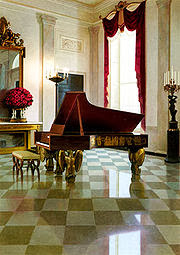In review--Travel back to the renaissance
Rolf Lislevand Ensemble
Diminuito
ECM Series
When Rolf Lislevand’s Nuove Musiche (ECM, 2006) arrived in my mailbox along with Trio Mediaeval’s 2006 ECM recording, I ended up with a stray Alaskan dog in my apartment. Trio Mediaeval’s recording had been playing in my apartment when the dog showed up at my backdoor. Now, how it found its way into the yard remains a mystery. I pulled the dog into my home and phoned its human companion. But in the meantime, the Alaskan dog gravitated towards the CD player and long before Joshua Leeds and Susan Wagner published the book, Through a Dog’s Ear. This dog preferred early music.
Shedding dog story aside, listening to the Norwegian early music lute player Lislevand and the Scandinavian early music vocal ensemble, Trio Mediaeval in a single afternoon opened some much needed doors for me, musically speaking. And now two of the TM vocalists, Linn Andrea Fuglseth and Anna Maria Friman appear on Rolf Lislevand Ensemble’s Diminuito, and the musicians headed back to the Renaissance to produce this gem.
Recorded in October 2007 and May 2008 at Propstei S. Gerold in Austria, Diminuito features compositions by Vincenzo Capirola, Joan Ambrosio Dalza, Giovanni Antonio Terzi, Diego Ortiz, Francesco da Milano and Alonso Mudarra. And in the liner notes, Lislevand described it as, “This recording is all about the Italian renaissance, how it understood itself, how we understand it today and how we would have understood it if we had been contemporary with it, because no other period in European music’s history was as contemporary with itself as the renaissance.”
True the renaissance was a time of the blossoming of science, publishing (printing press), and the arts. It was a time of King Louis XIV, Spanish conquistadors & the New World, William Shakespeare, Teresa of Àvila and Leonardi da Vinci. Changes happened within the Catholic Church too, with reformation and music started rearing its more secular head as well. Melodies contained more embellishments and according to Lislevand, “This supreme discipline of ornamentation became a new work of art in itself. The original composition on the other hand was reduced to a humble servant of invention…”
On this recording, Lislevand’s plucked lutes play alongside Giovanna Pessi’s triple harp, Marco Ambrosini’s nyckelharpa (Swedish keyed fiddle), Thor Harald Johnsen’s array of lutes, Michael Behringer’s clavichord/organ and Bjorn Kjellemyr’s colascione. Then TM brings in its ethereal vocals. The ear-catching songs gently speak for themselves—simple-sounding on the surface, but underneath a cauldron of embellished notes boils over, creating an experience that seemingly stops time from flowing onward.
What I mean by that, is anyone fascinated with the renaissance, the rise and fall of its kings, queens, the intrigue behind the scenes, and secular music of that era, will find themselves time traveling while listening to this collection of Italian and Spanish renaissance beauties. The plucked harp and lutes on Alonso Mudarra’s Fantasìa que contrahaze la harpa en la manera de Luduvico, (which recalls the West African kora), alone is worth the price of this recording. I have a difficult time imagining an era with such gorgeous folksongs, madrigals and popular music. With all the synthesized and noisy nonsense of contemporary popular music, I can easily escape into the comfort that this recording offers.
I have listened to this recording before falling asleep and I listen to it while I write, edit and perform work that takes a great deal of concentration. I find the instruments warm, inviting and the vocals mesmerizing. And I have been a fan of Rolf Lislevand for several years now, high recommendations all around.
ECM New Series
Diminuito
ECM Series
When Rolf Lislevand’s Nuove Musiche (ECM, 2006) arrived in my mailbox along with Trio Mediaeval’s 2006 ECM recording, I ended up with a stray Alaskan dog in my apartment. Trio Mediaeval’s recording had been playing in my apartment when the dog showed up at my backdoor. Now, how it found its way into the yard remains a mystery. I pulled the dog into my home and phoned its human companion. But in the meantime, the Alaskan dog gravitated towards the CD player and long before Joshua Leeds and Susan Wagner published the book, Through a Dog’s Ear. This dog preferred early music.
Shedding dog story aside, listening to the Norwegian early music lute player Lislevand and the Scandinavian early music vocal ensemble, Trio Mediaeval in a single afternoon opened some much needed doors for me, musically speaking. And now two of the TM vocalists, Linn Andrea Fuglseth and Anna Maria Friman appear on Rolf Lislevand Ensemble’s Diminuito, and the musicians headed back to the Renaissance to produce this gem.
Recorded in October 2007 and May 2008 at Propstei S. Gerold in Austria, Diminuito features compositions by Vincenzo Capirola, Joan Ambrosio Dalza, Giovanni Antonio Terzi, Diego Ortiz, Francesco da Milano and Alonso Mudarra. And in the liner notes, Lislevand described it as, “This recording is all about the Italian renaissance, how it understood itself, how we understand it today and how we would have understood it if we had been contemporary with it, because no other period in European music’s history was as contemporary with itself as the renaissance.”
True the renaissance was a time of the blossoming of science, publishing (printing press), and the arts. It was a time of King Louis XIV, Spanish conquistadors & the New World, William Shakespeare, Teresa of Àvila and Leonardi da Vinci. Changes happened within the Catholic Church too, with reformation and music started rearing its more secular head as well. Melodies contained more embellishments and according to Lislevand, “This supreme discipline of ornamentation became a new work of art in itself. The original composition on the other hand was reduced to a humble servant of invention…”
On this recording, Lislevand’s plucked lutes play alongside Giovanna Pessi’s triple harp, Marco Ambrosini’s nyckelharpa (Swedish keyed fiddle), Thor Harald Johnsen’s array of lutes, Michael Behringer’s clavichord/organ and Bjorn Kjellemyr’s colascione. Then TM brings in its ethereal vocals. The ear-catching songs gently speak for themselves—simple-sounding on the surface, but underneath a cauldron of embellished notes boils over, creating an experience that seemingly stops time from flowing onward.
What I mean by that, is anyone fascinated with the renaissance, the rise and fall of its kings, queens, the intrigue behind the scenes, and secular music of that era, will find themselves time traveling while listening to this collection of Italian and Spanish renaissance beauties. The plucked harp and lutes on Alonso Mudarra’s Fantasìa que contrahaze la harpa en la manera de Luduvico, (which recalls the West African kora), alone is worth the price of this recording. I have a difficult time imagining an era with such gorgeous folksongs, madrigals and popular music. With all the synthesized and noisy nonsense of contemporary popular music, I can easily escape into the comfort that this recording offers.
I have listened to this recording before falling asleep and I listen to it while I write, edit and perform work that takes a great deal of concentration. I find the instruments warm, inviting and the vocals mesmerizing. And I have been a fan of Rolf Lislevand for several years now, high recommendations all around.
ECM New Series




Comments
Post a Comment